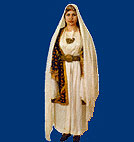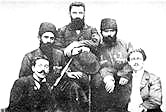About Russia
Nations of Russia
 The Mountain Jews
The Mountain Jews
Mountain Jews (also known as the Jukhuro) are the ethnolingvistic group of Jews. 11,3 thousand of them live in the Russian Federation. 3,6 thousand of them lives in the Daghestan, 3,2 thousand in the Kabardino-Balkariya, and 2,6 thousand persons live in the Chechen Republic and Ingushetia. There are also 5,5 thousand persons in Azerbaijan. The total number of the Mountain Jews is 18,5 thousand persons.
Their traditional occupations are: trade, gardening and viniculture. Crafts: carpet weaving, manufacturing of copper utensils and jewels. Their language is the Tatsky with the Makhachkalin- Nalchik, Derbent and Kuban dialects.
According to the official return, in 1835 4459 of the Mountain Jews (58,3 %) were villagers, and 3190 of them (41,7 %) were townspeople. The significant part of the townspeople was employed in an agriculture, mainly gardening, viniculture and winemaking (especially in Kuba and Derbent). They also were growing the madder for the manufacture of the red paint. Large winemaking companies were founded at the end of 19th century.
In the beginning of the 20th century with the manufacture of aniline dyes the madder growing has stopped. The owners of the plantations were ruined and had to turn into unskilled workers and seasonal workers. In some settlements of Azerbaijan the Mountain Jews were employed in the tobacco growing. In the Kaitag, the Tabasaran and in other villages of Azerbaijan they were employed in agriculture. Until the 20th century in some settlements the main occupation was tanning craft. From 1860th the Mountain Jews started to settle in cities of Baku, Temyr-Khan-Shura, Nalchik, Grozny and Petrovsk-port. By the end of the 19th century the number of the Mountain Jews employed in the petty trade has considerably grown. There were just a few prosperous dealers (mostly in the cities of Derbent, Baku and Buinaksk).
Until the end of 1920th the Mountain Jews were living by a big family with three or four generations and number of members of 70 persons and more. As a rule, the big family occupied one courtyard where each small family has the house. Until now, there was polygamy in the Mountain Jews family. Each wife with children occupied the separate house or, less often, a separate room in the common house.
The father was the head of the big family, after his death the senior son became a head of the family. The head of a family was in charge of property, which considered to be a collective property of all family members, he appointed men of family to work. Mother of family (or the first wife) was keeping house and supervised female works: cooking, cleaning etc. A few big families, who descended from the common ancestor, formed the Tukhum.
Women and girls were leading the closed life, not to be seen by the stranger. Engagement was frequently made at infantile age. For the bride was paid the Kalyn (bride money). The Mountain Jews had the customs of hospitality, mutual aid and blood feud. Fraternization with representatives of the neighboring mountain nations was common. The Mountain Jews villages were near to the neighboring nations villages, in some places they were living together. The Mountain Jews settlement consists, as a rule, of four or five big families. In cities the Mountain Jews lived in special suburb (Kuba) or in separate quarter (Derbent). At the end of 19th century process of disintegration of the big family began.
In the material culture the Mountain Jews are close to the neighboring nations. In the villages the Mountain Jews had houses with two or three rooms: for men, for visitors, for women with children. The children room was better furnished and decorated with the weapon.
 From the neighboring nations the Mountain Jews borrowed many pagan rites and superstitions. They consider the world to be inhabited by the kind and evil spirits. For example, Num-Negear is the lord of travelers and home life, Ile-Nove is Ilya the Prophet, Ozhdegoe-Mar is the house spirit, and Ser and Shegadu are malicious spirits. To honour Gudur-boy and Kesen-boy (the spirits of an autumn and spring) the Mountain Jews arranged special festivals. The Shev-Idor celebration is dedicated to the Idor master of a vegetative empire. On the eve of spring festival girls were making divination on the flowers in the forest.
From the neighboring nations the Mountain Jews borrowed many pagan rites and superstitions. They consider the world to be inhabited by the kind and evil spirits. For example, Num-Negear is the lord of travelers and home life, Ile-Nove is Ilya the Prophet, Ozhdegoe-Mar is the house spirit, and Ser and Shegadu are malicious spirits. To honour Gudur-boy and Kesen-boy (the spirits of an autumn and spring) the Mountain Jews arranged special festivals. The Shev-Idor celebration is dedicated to the Idor master of a vegetative empire. On the eve of spring festival girls were making divination on the flowers in the forest.
The Mountain Jews observe the religious traditions connected to life cycle (circumcision, wedding, funeral). They consume ritually suitable food (Kosher). They celebrate such holidays as the Yom-Kippur (the Judgment Day), the Rosh-Kha-Shakha (the New Year Eve), the Easter (Nisonu), Purim (Gomunu).
The professional storytellers (Ovosunachy) perform the fairy tales (the Ovosuna) and poets - singers (M 'nikhu) perform the poems - songs (M 'ny).
NATIONS OF RUSSIA
The Adygy I
The Aguls I
The Akhvakhs I
The Aleuts I
The Altaians I
The Andians nations I
The Andins I
The Archins I
The Armenians I
The Aserbaijanians I
The Assyrians I
The Avars I
The Baghulals I
The Balkarians I
The Baraba Tatars I
The Bashkirs I
The Besermians I
The Bezhtians I
The Botlikhs I
The Bulgarians I
The Buryats I
The Byelorussians I
The Chamalals I
The Chechens I
The Cherkess I
The Chukchis I
The Chuvashs I
The Cossacks I
The Crimean Tatars I
The Dargins I
The Didos I
The Dolgans I
The Enets I
The Eskimos I
The Estonians I
The Evenks I
The Evens I
The Finns I
The Gagauz I
The Georgians I
The Germans I
The Ginukhs I
The Godoberins I
The Greeks I
The Gypsies I
The Hunzibs I
The Ingush I
The Itelmens I
The Izhorians I
The Jews I
The Kabards I
The Kalmyks I
The Karachay I
The Karatas I
The Karelians I
The Kazakhs I
The Kets I
The Khakass I
The Khants I
The Khvarshis I
The Komi-Permyaks I
The Komis I
The Koreans I
The Koryaks I
The Kumuks I
The Kyrgyz I
The Laks I
The Latvians I
The Lezgins I
The Lithuanians I
The Mansis I
The Maris I
The Moldovans I
The Mordvins I
The Mountain Jews I
The Nanais I
The Negidals I
The Nenets I
The Nganasans I
The Nivkhs I
The Nogays I
The Orochis I
The Oroks I
The Ossetians I
The Permyak Komis I
The Poles I
The Russians I
The Rutuls I
The Saams I
The Selkups I
The Shors I
The Small Nations of North I
The Tabasarans I
The Tajiks I
The Tatars I
The Tats I
The Teleuts I
The Tofalars I
The Tsakhurs I
The Turkmens I
The Tyva I
The Udeghes I
The Udmurts I
The Ukrainians I
The Ulchis I
The Uzbeks I
The Veps I
The Vods I
The Yakuts I
The Yukaghirs I
|